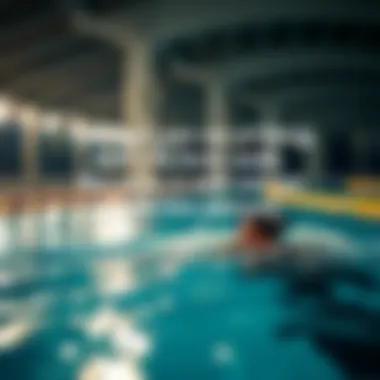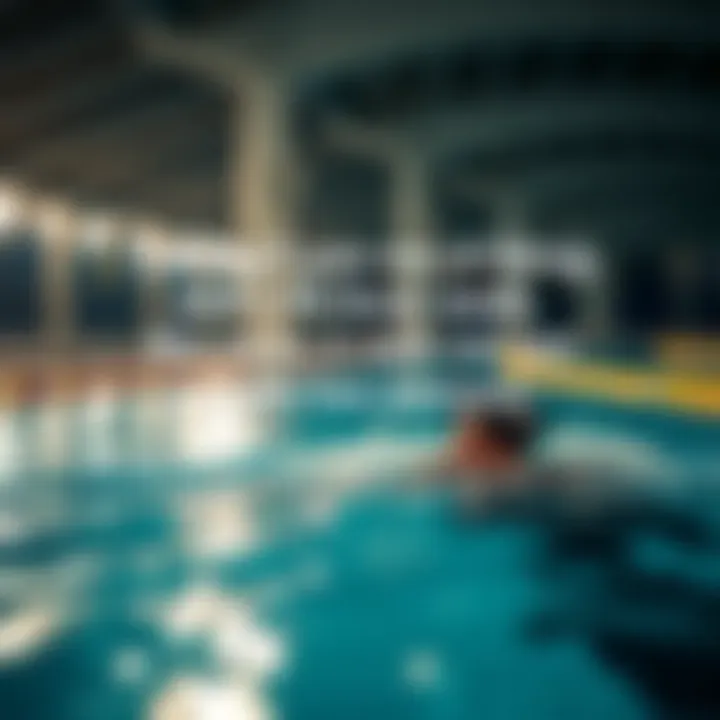Swimming for Weight Loss: A Transformative Journey


Intro
In the journey of weight loss, each step often feels like an uphill battle. Anyone who has tried shedding those extra pounds knows the struggle, the frustrations, and the occasional setback. But what if there’s a fun and refreshing alternative that not only helps in losing weight but also promotes overall well-being? Enter swimming – a powerful exercise that many overlook in their weight loss efforts.
This article dives into the transformative power of swimming, exploring its numerous benefits and providing a comprehensive guide for individuals aiming to change their lives – both physically and mentally. Just like a fish takes to water, individuals can thrive in their weight loss journey through effective swimming techniques, tailored nutrition, and constant motivation. The discussions ahead will serve as a roadmap, ensuring that you not only start strong but maintain momentum all the way until your goals are achieved.
Let’s dive into the myriad health benefits that swimming offers, laying the foundation for understanding how it can make a substantial difference in your weight loss journey.
Foreword to Swimming for Weight Loss
Swimming, often perceived merely as a recreational activity or a fun summer pastime, transforms into a powerful tool for weight loss when approached with intention and persistence. In the ever-evolving landscape of fitness strategies, swimming stands out not just for its calorie-burning potential but also for its holistic benefits. It's a low-impact exercise, making it an excellent choice for individuals of varying fitness levels, especially for those who may experience discomfort during high-impact workouts.
This section explores the foundational elements of swimming as a practical method for weight loss. Understanding the activity itself helps to appreciate its myriad advantages, from cardiovascular improvements to enhanced mental well-being. By providing insights into the mechanics of swimming, we lay the groundwork for appreciating its weight loss efficacy fully.
Understanding the Basics of Swimming
Swimming engages a broad spectrum of muscle groups, and knowing the basics is crucial before diving in. From freestyle to breaststroke, every style harnesses unique movements that contribute to overall fitness.
The key points include:
- Water Resistance: Each stroke against water creates resistance, making your body work harder than it would on land. This extra challenge leads to increased caloric burn, often translating to more effective weight loss.
- Breathing Techniques: Mastering control over breathing is vital when swimming. Techniques such as rhythmic breathing stabilize oxygen intake, supporting endurance and reducing fatigue.
- Body Positioning: Proper form allows for streamlined movement, minimizing drag, which not only makes swimming more efficient but also enhances the effectiveness of each stroke.
Why Swimming is Effective for Weight Loss
The effectiveness of swimming in weight loss can be attributed to several interconnected factors:
- Consistent Caloric Burn: Swimming can burn anywhere from 400 to 700 calories per hour, depending on the intensity and body composition of the swimmer. This higher caloric expenditure makes it a compelling weight loss activity.
- Increased Metabolism: Regular swimming raises resting metabolic rate, causing the body to continue burning calories even after the workout is complete, a phenomenon known as the afterburn effect.
- Full-Body Workout: Engaging multiple muscle groups simultaneously, swimming promotes muscle development alongside fat loss, ensuring that weight loss translates to a toned physique rather than just reduced numbers on the scale.
- Reduced Risk of Injury: Water buoyancy lowers the risk of strain or injury common with other forms of exercise, making swimming not only safer but also sustainable in the long term.
- Mental Health Benefits: Swimming is often described as meditative due to its rhythmic nature and soothing water environment. This mental aspect can be crucial in maintaining motivation and consistency toward fitness goals.
"Swimming is not just a workout; it’s a lifestyle. As much as it burns calories, it nourishes the mind and spirit too."
The Physiological Impact of Swimming
Swimming is more than just a leisurely activity; it’s an endeavor that holds numerous physiological benefits, particularly when it comes to weight loss. The gentle resistance of water allows individuals to engage in a low-impact exercise that significantly enhances overall bodily function. Understanding these impacts helps swimmers leverage swimming as an effective weight loss tool.
Caloric Expenditure and Metabolism
When you slip into the water, your body works tirelessly to maintain buoyancy and propel itself forward. This effort translates to a notable expenditure of calories. Swimming can be particularly potent for burning fat because it engages various muscle groups while still being easier on the joints compared to high-impact activities like running or aerobics.
To put it into perspective, a 160-pound (about 72.5 kg) person can burn approximately 423 calories per hour swimming at a moderate pace. This number soars even higher—up to about 715 calories—for vigorous activities like butterfly or freestyle sprints. Hence, not only does swimming provide a powerful workout, but it also boosts metabolism. The afterburn effect, or excess post-exercise oxygen consumption (EPOC), also plays a role. Post-swim, your body continues to consume oxygen at an elevated rate—which means more calories burnt even when you’re lounging on the couch.
"Swimming provides a unique combination of cardiovascular and resistance training benefits, meriting its position as a top choice for sustainable weight loss."
For those keen on maximizing caloric burn, employing interval training within swim routines can prove effective. Alternating bursts of intense efforts followed by shorter rest periods can enhance the metabolic response. Structuring workouts in this way can further elevate the calorie count burned during each session.
Muscle Engagement and Strength Development
Unlike many forms of exercise that focus on specific muscle groups, swimming engages almost all muscles across your body. The resistance posed by water makes each stroke not only a cardiovascular effort but also a strength-building endeavor. Every kick, stroke, and pull contributes to the development of lean muscle, which in turn, accelerates fat loss.
When you swim regularly, you harness the opportunity to develop strong core muscles essential for stability. Your legs power through the water, and your arms propel you forward, meaning those muscle fibers undergo intense engagement. This holistic engagement strengthens muscles while remaining low-impact, preserving joint health.
Moreover, swimming improves flexibility and balance, as the range of motion required in various strokes encourages elongation of the muscle fibers. Enhanced coordination through swimming naturally leads to better muscle definition and overall strength durability, which is what so many strive for in their fitness journeys.
Preparing for Your Swimming Journey
Embarking on the journey of swimming for weight loss is as much about preparation as it is about execution. It sets the stage for a transformative experience that goes beyond just shedding pounds. Proper preparation can mean the difference between a fleeting interest and a sustainable lifestyle change. This section aims to guide you through crucial elements that can maximize your effectiveness and enjoyment in the water.
Setting Realistic Weight Loss Goals


When it comes to losing weight through swimming or any form of exercise, setting realistic goals is paramount. Aim for a target that is not only achievable but also maintainable over time.
- Assess Your Starting Point: Before jumping into the pool, take stock of where you are in your fitness journey. This includes your current weight, swimming proficiency, and time you can commit each week.
- SMART Goals: Implement SMART criteria - Specific, Measurable, Achievable, Relevant, and Time-bound. Instead of saying, "I want to lose weight," consider something like, "I aim to lose five pounds in two months by swimming three times a week."
- Celebrate Small Wins: Losing weight can be a slow process, so break it down into smaller milestones. Whether it’s swimming a certain number of laps or tracking your endurance, every small victory counts.
By setting well-thought targets, you're more likely to stay focused and less prone to discouragement along the way.
Creating a Swim Schedule
Now that you've established your goals, the next step is to carve out a swim schedule that aligns with your lifestyle. Consistency is key in any weight loss endeavor, and having a dedicated time for swimming each week will help you foster a habit.
- Evaluate Your Availability: Look closely at your daily routine. Are you a morning person or do you find you swim better in the evening? Find the time slot that works best for you.
- Be Flexible: Life happens, and some days won’t go as planned. Build flexibility into your schedule. If you miss a swim session, don't beat yourself up; instead, try to make it up later in the week.
- Mix It Up: While consistency is important, it can become mundane. Consider alternating between different swimming locations or varying your swim partners to keep things fresh.
A well-thought-out schedule not only enhances your swimming experience but also contributes significantly to weight loss.
Essential Gear and Equipment
Having the right equipment can greatly impact your swimming performance and, in turn, your weight loss journey. Investing in quality gear ensures comfort, safety, and effectiveness.
- Swimsuit: Depending on your comfort level, you may prefer a one-piece or two-piece swimsuit. Make sure it fits well; a good fit will help you move more efficiently through the water.
- Goggles: A good pair of goggles not only protects your eyes but also enhances your swimming experience by allowing you to see clearly underwater.
- Swim Cap: Especially useful if you're swimming in chlorinated pools, a swim cap can protect your hair while helping you glide better in the water.
- Kickboard: This tool is great for isolating your legs and improving both strength and technique.
- Fins: If you're looking to build strength and enhance your kick, fins can help you swim faster and improve your overall technique.
"Preparation is the key to success."
Making sure you have the right essential gear can ease the transition into regular swimming, help you stay motivated, and accelerate your progress.
By laying down a solid foundation—setting achievable goals, crafting a flexible swim schedule, and investing in essential equipment—you put yourself on a path toward success in your swimming journey for weight loss.
Techniques for Swimming Effectively
When it comes to losing weight through swimming, utilizing effective techniques can make all the difference. Not only can the right strokes enhance performance, but they can also maximize caloric burn, making each lap count. Understanding your swimming techniques empowers you, allowing for a more tailored approach to your fitness goals. Furthermore, essential elements such as the proper form and stroke mechanics play a crucial role in developing endurance and minimizing fatigue.
Swimming isn't just about splashing around; it’s a dynamic workout that incorporates various styles. Each stroke carries its own unique set of benefits, helping you cater your workouts to your individual needs.
Different Swimming Styles and Their Benefits
- Freestyle (Front Crawl)
- Breaststroke
- Backstroke
- Butterfly
- Efficiency: Freestyle is often praised for being the fastest swimming style. As you glide through the water, it's an excellent way to build cardiovascular endurance.
- Muscle Engagement: It primarily engages the upper body, core, and helps enhance lung capacity. This makes it a robust option for anyone looking to tone their entire body.
- Beginner-Friendly: This style is often easier for those just starting. The slower pace allows swimmers to focus more on technique without the frantic pace.
- Strength Building: It places emphasis on the chest, triceps, and inner thighs, making it a great choice for toning these areas.
- Posture Improvement: Backstroke encourages good posture and can alleviate tension in your neck and shoulders.
- Unique Health Benefits: It’s great for cardiovascular health, similar to freestyle, but requires different muscle engagement, making a well-rounded workout regimen possible.
- Intense Workout: This one is not for the faint-hearted. The butterfly is all about power and coordination, providing an excellent workout that targets the back, shoulders, and abs.
- Caloric Burn: Due to its demanding nature, the butterfly can burn more calories in a shorter amount of time, making it effective for quick weight loss sessions.
Each swimming style offers its own unique benefits, so varying the strokes you use can keep your routine fresh, reduce boredom, and challenge different muscle groups.
Breathing Techniques and Endurance Building
Effective breathing techniques play a monumental role in swimming. They not only support your performance but also help with overall endurance. Mastering your breathing can be a game changer, particularly in longer swimming sessions.
Key Breathing Techniques:
- Rhythmic Breathing: Establishing a consistent breathing rhythm is crucial. For freestyle, this often means inhaling through the mouth when your head turns to the side and exhaling into the water.
- Controlled Breaths: Instead of gasping for air, practice controlled deep breaths. This helps in taking in more oxygen, aiding stamina.
- Breath Timing: Coordinate breaths with your strokes. Finding that sweet spot reduces the chances of disrupting your stroke pattern.
- Nasal Breathing: Some swimmers opt for exhaling through the nose. This can prevent water from entering through your mouth and improve overall comfort.
Building Endurance Through Breathing:
- Interval Training: Incorporate sets of fast-paced swimming followed by slower recovery swims to enhance oxygen uptake.
- Increased Duration: Gradually extend your swims. Start at a distance you’re comfortable with, and slowly increase it over time.
- Combination Drills: Combine different strokes within your workout to prevent fatigue and keep the heart rate elevated without compromising form.


In summary, refining both your swimming styles and breathing techniques is essential to effective weight loss through swimming. This holistic approach not only shapes how you swim but it also fosters a deeper impact on your overall fitness journey.
Integrating Nutrition with Swimming
Swimming for weight loss is not just about the laps you swim or the hours you spend in the pool. Integrating proper nutrition into your swimming regimen is equally significant. While swimming burns calories and builds muscle, what you consume plays a crucial role in achieving your weight loss goals. If you pair swimming with appropriate dietary choices, you can amplify the effects, making your effort more efficient and fruitful.
Understanding Nutritional Needs for Weight Loss
To grasp why nutrition is so vital, it helps to understand the body’s demands during a weight loss journey. When you engage in swimming, your body needs fuel—both for energy and recovery. Here are some key points regarding nutritional needs:
- Caloric Intake: Consuming fewer calories than you burn is essential for weight loss. However, this doesn’t mean skimping on nutrition. You need to ensure that you’re fueling your body to sustain energy levels and enhance performance.
- Macronutrients: A balanced intake of proteins, carbohydrates, and fats is necessary. Proteins help repair muscles, carbs provide energy, and healthy fats support overall bodily functions. Each component contributes in its own way to maximize your effectiveness in the pool.
- Micronutrients: Vitamins and minerals also hold importance. For instance, calcium and vitamin D are crucial for bone health, which is essential for swimmers. Iron is fundamental for energy production, helping prevent fatigue.
Therefore, understanding and adapting your dietary plan to meet these nutritional needs will set a solid foundation for your swimming program.
Pre and Post Swim Nutrition Strategies
Eating the right foods before and after a swim can make a world of difference. Here are some nutritional strategies to consider:
Pre-Swim Nutrition
- Timing: Ideally, have a meal 2-3 hours prior to swimming. This allows your body to digest.
- Food Choices: Consuming foods rich in carbohydrates with moderate proteins is recommended. Think of oatmeal with fruits, whole-grain toast with avocado, or a yogurt parfait. These are good sources of energy that will keep you fueled.
Post-Swim Nutrition
- Timing: After swimming, it’s wise to refuel within 30 to 60 minutes. This is when your body needs nutrition the most to recover effectively.
- Food Choices: Focus on protein-rich foods to help repair muscles. A smoothie with protein powder, banana, and spinach works wonders, or a chicken salad with quinoa can be incredibly beneficial. Don’t forget to hydrate as well—water is essential for recovery.
"Nutrition is the key that unlocks the door to your best performance."
By carefully considering what goes in before and after swimming, you’ll improve your results substantially and ensure the sustainability of your weight loss journey.
Tracking Progress and Measurement
Monitoring weight loss in the context of swimming is not merely about the numbers dwindling on the scale. It's about understanding how your body reacts and adapts to this aquatic workout over time. Weight loss is often a long and winding road filled with ups and downs, and tracking progress can be a game-changer when it comes to motivation and adaptability in your swimming regime.
Methods for Monitoring Weight Loss
Assessing weight loss through swimming can hinge on various methodologies. While stepping on the scale at home has its merit, it's important to tiptoe into a variety of methods to have a fuller image of your progress. Here are some strategies you might find beneficial:
- Regular Weigh-Ins: Consider weighing yourself once a week rather than daily, as daily fluctuations can be misleading. Choose a consistent time, such as every Saturday morning after your first bathroom visit, to keep things straightforward.
- Body Measurements: Sometimes, the scale might not budge, but you could be losing inches. Use a measuring tape to track changes in your waist, hips, and chest. Write it down to see changes over time, even when your weight is stagnant.
- Fitness Tracking Apps: Use apps that help integrate your swimming data, like Swim.com or MySwimPro. These tools can track your distances, times, and calories burned—valuable insights that provide an overview beyond just weight.
- Heart Rate Monitoring: Utilizing a heart rate monitor can be insightful. It lets you know how hard you're working in the pool and if you're in the fat-burning zone, which is crucial for weight loss.
- Progress Photos: Sometimes pictures can show what numbers cannot. Take photos of yourself regularly, in the same lighting and position, to visually document your transformation journey.
This varied approach can help avoid the pitfall of fixating on a single number and deepen your understanding of your body's response to swimming.
Assessing Fitness Improvements
The fitness aspect of swimming transcends weight loss alone; it's about prosperity in overall health and capabilities. Here’s how you can gauge your fitness improvement:
- Monitoring Swim Times: Keep an eye on your lap times. If you’re able to swim the same distance in lesser time as weeks pass by, it indicates an uptick in both stamina and speed—two key attributes in swimming that go hand-in-hand with fitness improvement.
- Increased Endurance: Notice how you feel during swims. Are you able to swim longer distances without feeling as fatigued? This gradual increase in workout duration is a salient sign that your cardiovascular fitness is enhancing.
- Enhanced Technique: Swimming is as much about technique as it is about brute strength. Regular practice should lead to smoother strokes and better efficiency in the water, providing you with a clearer sense of achievement.
- Reduced Recovery Time: Pay attention to how quickly you bounce back post-swim. If you find that your muscles recover faster from workouts than they did when you first started, that is a promising indicator of improved fitness levels.
Keeping tabs on these facets of fitness improvement, along with tracking methods, offers a more balanced understanding of progress on this transformative journey. By viewing weight loss through this broader lens, not only do you cultivate a healthier body, but you also foster a healthier mindset around body image and success.
Mental Aspect of Swimming for Weight Loss
Swimming is not merely a physical endeavor; it is deeply intertwined with mental health and motivation, especially for those embarking on a weight loss journey. Understanding the psychological elements at play can bolster the effectiveness of this low-impact workout. Engaging in swimming can shift one's mindset, transforming how individuals perceive their capabilities and limitations. With water surrounding them, swimmers can often shed feelings of heaviness, both literally and figuratively. Here, we dive into the mental components that hold great significance for anyone considering swimming as a weight management strategy.
Staying Motivated Throughout Your Journey
The road to sustainable weight loss is rarely a straight path. Motivation is pivotal in overcoming obstacles and keeping the momentum going. In the context of swimming, motivation can stem from several sources:


- Setting Achievable Milestones: Establishing short-term goals can create a sense of accomplishment. For instance, aiming to swim an additional lap each week provides tangible progress that can spur a swimmer on.
- Tracking Progress Verbally: Keeping a written or verbal log of swimming sessions not only helps in monitoring progress but also encourages reflection. It’s a reminder of how far you have come.
- Visualization Techniques: Many swimmers utilize mental imagery to envision themselves achieving their goals. Whether it’s picturing completing a swim session or visualizing hitting a weight target, this practice can reinforce one’s intentions.
- Enjoying the Process: Choosing a swimming style or technique that excites you enhances enjoyment. Maybe it’s freestyle or sunkissed backstroke for you? Keeping it fun breaks monotony and boosts motivation.
- Celebrating Small Wins: It's important to applaud each accomplishment. Completed a difficult workout? Celebrate that! Completed 10 swim sessions? Reward yourself, maybe with a new swim cap.
Incorporating these elements into your swimming practice can break down a daunting weight loss journey into a series of gratifying experiences, keeping motivation levels high and spirits even higher.
Building a Support System
While swimming can be a solitary activity, having a support system amplifies success. Engaging with others creates a shared sense of purpose and accountability. Here’s how you can cultivate a supportive environment:
- Join a Swim Team or Club: Being part of a group can infuse camaraderie into your routine. The collective experience can keep you accountable while providing social interactions that foster lasting relationships.
- Find a Swimming Buddy: Partnering up for swim sessions can not only make workouts more enjoyable but also encourage consistent attendance. A buddy’s presence serves as a motivational push on days when laziness creeps in.
- Utilize Online Communities: Platforms like Reddit or specialized health forums offer spaces for sharing experiences, advice, or simply connecting with like-minded individuals. Engaging with others online can ease feelings of isolation.
- Communicate Your Goals: Speaking openly about your objectives with friends or family creates an environment where supporters can encourage and remind you of your aspirations when motivation wanes.
- Seek Professional Guidance: Hiring a swimming coach or joining a swim program can provide not just expertise but also an additional layer of support and encouragement.
Building this support network may seem like an extra step, but it can drastically influence the enjoyment and sustainability of your swimming routine.
"The beauty of swimming lies not only in the strokes turned but in the connections forged along the way."
In sum, swimming for weight loss is deeply influenced by mental dynamics. Staying motivated requires strategy, while a strong support system cultivates an empowering environment. Together, these aspects contribute significantly to enhancing one’s commitment to this engaging, refreshing journey.
Before and After: Real-Life Transformation Stories
The journey of weight loss through swimming isn’t just about the physical transformation; it's also about the mental and emotional shifts that accompany it. Sharing real-life transformation stories can inspire others to embark on their own swimming journey. These stories are not just narratives, but powerful reminders of the commitment, perseverance, and resilience needed in the pursuit of fitness and health. They reflect diverse experiences and highlight the unique hurdles individuals face along the road to achieving their goals.
Case Studies of Successful Weight Loss
Individual stories paint a vivid picture of what can be achieved through swimming. Take, for instance, the journey of Linda, a 36-year-old mother of two who struggled with post-pregnancy weight gain. When she started swimming, she was hesitant at first, standing at the edge of the pool, wondering if she could actually make a change. However, with a structured routine of three times a week, she gradually built her stamina. Within six months, Linda shed over 25 pounds. Her story is not just about the weight loss; it’s also about how her confidence grew as she discovered the joy of movement in water.
Another compelling example is Tyler, who started over 100 pounds overweight. Initially, he could barely swim a lap. However, he immersed himself in learning proper techniques and gradually increased his swim time and distance. A little more than a year in, he achieved a remarkable transformation, losing half of his body weight. Tyler’s case underlines the importance of starting where you are and insists that every stroke counts, no matter how small.
Lessons Learned from Swimming Experiences
Such case studies ignite the spirit of change, showcasing not only the physical impact but also the lessons learned. For example:
- Patience is Key: Many swimmers, like Linda and Tyler, discovered that results take time. The road isn’t linear, and plateaus are a natural part of the journey.
- Strength in Community: Both individuals found support in swimming communities, which encouraged them to keep going when motivation waned.
- Variety Over Monotony: Mixing up swimming styles kept workouts engaging and encouraged continual growth in both skill and fitness.
- The Importance of Goal Setting: Setting and revisiting specific targets proved essential for maintaining focus and momentum. Linda aimed for small milestones like swimming a certain distance without stopping, while Tyler tracked lap counts.
These real-life stories don’t merely serve as motivational narratives; they act as beacons of encouragement for those considering swimming as a means to shed unwanted pounds. They remind us that every journey is unique and illustrates the life-changing impact of consistent effort in the pool.
"The greatest glory in living lies not in never falling, but in rising every time we fall." – Nelson Mandela
Such stories are testaments to the power of swimming in transforming lives. They serve as both motivation and a call to action for those who have yet to take the plunge.
For more inspiring stories and resources on weight loss through swimming, check out Wikipedia or browse community forums on Reddit dedicated to fitness.
Finale: Embracing Swimming as a Weight Loss Strategy
As we reach the end of our exploration into the intersection of swimming and weight loss, it's imperative to recognize the multifaceted nature of this activity. Swimming is not just a form of exercise; it's a holistic approach to enhancing one’s well-being while shedding pounds. In this section, we’ll delve into the pivotal role swimming plays in weight management, touching on specific elements, benefits, and considerations that encapsulate its significance.
Swimming offers a low-impact environment that is accessible to a broad spectrum of individuals. It often reduces the risk of injury while still providing a demanding workout that can burn significant calories. The buoyancy of water supports the body, thus allowing those with joint issues or excess weight to engage in physical activity without undue strain. This becomes particularly important for individuals starting their weight loss journey, who may find traditional forms of exercise daunting.
Furthermore, swimming is a unique blend of cardio, strength training, and flexibility work. As you glide through the water, multiple muscle groups engage, leading to better muscle tone and strength improvement. With each stroke, you not only increase your heart rate but also boost metabolic functions, propelling the body to utilize stored fat as an energy source.
Equally essential in considering swimming for weight loss is the social aspect of it. Swimming can be a communal activity, fostering a sense of camaraderie that enhances motivation. Joining a swim team or simply splashing around with friends or family can elevate the experience beyond mere exercise, making it more enjoyable in the long run.
In summary, embracing swimming as a weight loss strategy is not merely about the immediate results on the scale. It’s about adopting a lifestyle that fosters long-term health and well-being. The cumulative benefits – from enhanced physical strength to improved mental clarity – converge into a powerful motivator for sustainable weight management.
Final Thoughts on Sustainable Weight Management
To maintain weight loss effectively, it is vital to have a strategic mindset towards sustainable management. Swimming, when paired with a healthy diet and lifestyle choices, forms a comprehensive routine that can lead to lasting results. Understand that weight loss is not just an endpoint but an ongoing journey. Setting small, achievable goals can pave the way for larger achievements. For instance, aiming to swim a certain distance without stopping or mastering a new stroke can keep the process engaging and rewarding.
In addition, regularly re-evaluating your goals and methods is essential. As one progresses, what initially seemed challenging can become second nature, necessitating the need for new challenges to prevent plateauing. Moreover, pairing your swimming routine with a balanced diet tailored to your body's needs reinforces the effort you put in the pool.
Encouragement for Continued Journey
Your journey through swimming towards weight loss can be fraught with ups and downs. It’s normal to hit a few bumps or even take a step back at times. The key is to remain patient and persistent. Celebrate small victories, whether it’s swimming an additional lap or feeling more agile in the water. These milestones can all add up remarkably.
Moreover, remember to surround yourself with a supportive network. Whether it's friends who share a similar goal or local swimming clubs, having others cheer you on can make all the difference. Engaging in communities, both online and offline, can provide motivation and fresh perspectives.
In the end, swimming is a journey of transformation, offering benefits that extend well beyond the physical realm. Embrace it not only as a tool for weight loss, but as an enjoyable, rewarding practice that enriches all aspects of your life. With each stroke, you’re not just moving towards a weight goal, you’re enhancing your overall health and quality of life.















